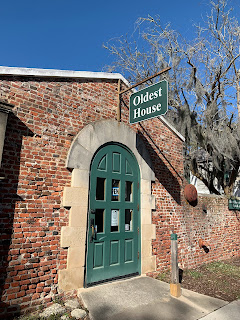St. Augustine, FL
February 17, 2022
The Oldest House Museum Complex is a special part of St. Augustine's history. The site is run by the St. Augustine Historical Society. Many different exhibits are held in the complex that displays the elements and parts of history that shaped St. Augustine into the city it is today. From the Surf Culture Museum to the gallery to the oldest house itself, walking the property brings to life the past in a special way.
Oldest House Museum Complex Website: https://staughs.com/oldest-house-museum-complex/
Artifact 1
The gallery at the Oldest House Museum Complex contains numerous artifacts, maps, and photos of St. Augustine's history. The photo above is a part of a recent collection of glass photos that were found being thrown out. These valuables were taken and turned into a fascinating exhibit for the public to experience. The photos display the African American part of St. Augustine's history which is vital to the shaping of the city. This particular photo above is of St. Benedict the Moor Church. This church was built in 1911 and is located in the Lincolnville district. Recently undergoing renovations, this catholic church still serves the community today.
Artifact 2
A recent addition to the Oldest House Museum Complex, the Surf Culture Museum is a fascinating part that exhibits the importance of the surf community in St. Augustine. The photo above is a collection of surfboards that have been collected from St. Augustine surf legends. In this exhibit, you can find the history behind the start of surf culture in town as well as the creation of surfboards, oral histories, mementos, and stories from surfer legends. Surfing is a big part of this town's history that built and shaped the community and that history is preserved in a fun and interactive way in the Surf Culture Museum.
Exterior 1
Exterior 2
In Conversation Image 1
The Fairbanks House in Dedham, Massachusetts was built sometime between 1637 and 1641 and is considered the oldest wood structure in North America. The house that is still standing is currently a museum but housed Jonathan and Grace Fairbanks when it was built in the 16th century. Jonathan and Grace Fairbanks along with their six children lived in this house and for the next 268 years after them, generations of the Fairbank family resided in the residence. This structure is a historic site that visitors from all around go to see.
Photo Link: https://locationsoflore.com/2018/09/29/history-and-hauntings-at-the-fairbanks-house/
In Conversation Image 2
The Surf Station is a major part of St. Augustine's community. The Surf Culture Museum referenced a lot of Surf Station in the exhibit. This surf shop started out as a gas station until it was purchased in June of 1984. Troy Strange had big dreams for this shop and little did he know at the beginning how much of an impact it would make on the locals and visitors of St. Augustine. Until 1995 the Surf Station acted as both a gas station and a surf shop. When the gas station became a distraction, the Surf Station truly became its own brand and has since grown beyond Strange's dreams. Surf Station loves its community and the community loves the shop. St. Augustine would not be the same without this place.
Photo Link: https://www.visitstaugustine.com/thing-to-do/surf-station
In Conversation Literature
One Hundred Love Sonnets
Pablo Neruda
"I love you as the plant that doesn't bloom but carries
the light of those flowers, hidden, within itself,
and thanks to your love the tight aroma that arose
from the earth lives dimly in my body."
History is kept alive through our acts of preservation. Without taking care of the past, it will be forgotten. I found that Pablo Neruda connected the love of a plant to preserving history. "I love you as the plant that doesn't bloom but carries the light of those flowers, hidden, within itself" can relate to the way that we preserve the memory and legacy of passed people or the architecture of a building even though we did not personally meet that person or live through that time period of that building when it was in full use. The light of memories from the past is carried and kept alive for future generations to learn from and appreciate.
Creative Component


























